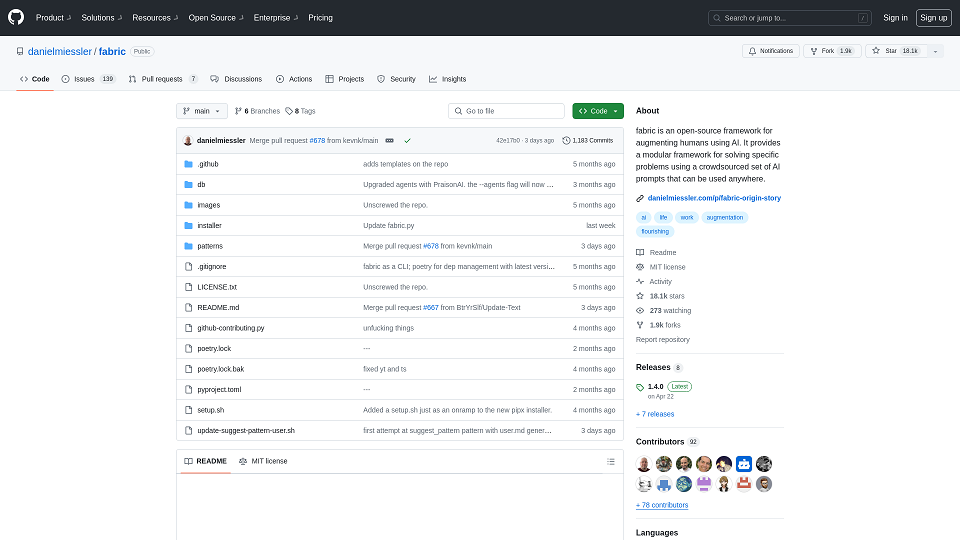GitHub - danielmiessler/fabric: fabric is an open-source framework for augmenting humans using AI. It provides a modular framework for solving specific problems using a crowdsourced set of AI prompts that can be used anywhere.
fabric is an open-source framework for augmenting humans using AI. It provides a modular framework for solving specific problems using a crowdsourced set of AI prompts that can be used anywhere. - danielmiessler/fabric

fabric Introduction
Fabric is an open-source framework designed to enhance human capabilities using AI. It offers a modular approach to problem-solving by leveraging a community-driven collection of AI prompts, referred to as 'Patterns,' which can be utilized across various applications. Fabric's philosophy centers around the idea that AI serves as a tool to amplify human creativity. The framework aims to address the challenge of integrating AI into daily life by providing granular solutions for specific tasks. Fabric's structure is inspired by woven materials, with components named 'Mill' (server hosting Patterns), 'Patterns' (individual AI use cases), 'Stitches' (chained Patterns for advanced functionality), and 'Looms' (client-side apps accessing Patterns). The framework is command-line native, allowing users to execute Patterns directly or set up their own server for API calls. Fabric also supports custom Patterns, enabling users to create and manage their own prompts locally. Additionally, Fabric incorporates PraisonAI for creating and utilizing AI agents to perform tasks. Helper apps like 'yt' (YouTube transcript extractor) and 'ts' (audio transcriber) are provided to facilitate interaction with external media. The 'save' utility allows users to pipeline content saving while preserving the output stream. Fabric emphasizes community contributions and encourages users to share and improve upon existing Patterns.
fabric Use Cases
Extracting insights from YouTube videos and podcasts.
Writing essays and other content in a personalized voice.
Summarizing academic papers and other complex documents.
Generating AI art prompts from written content.
Rating the quality of content.
Summarizing long-form content.
Explaining code.
Improving documentation.
Creating social media posts.
Automating tasks using AI agents.
Core features of fabric
Modular framework for solving specific problems using AI prompts (Patterns).
Crowdsourced collection of Patterns for various life and work activities.
Command-line native interface for executing Patterns and setting up a personal AI server (Mill).
Support for custom Patterns.
Integration with PraisonAI for creating and utilizing AI agents.
Helper apps for extracting transcripts from YouTube videos and transcribing audio files.
Utility for pipelining content saving while preserving the output stream.
fabric Frequently Asked Questions
What is Fabric?
Fabric is an open-source AI framework that uses crowdsourced prompts ('Patterns') to augment human capabilities. It offers a modular, command-line native approach to integrating AI into daily life, providing solutions for various tasks and enabling users to create and share their own Patterns.
How do I use Fabric?
You can use Fabric by cloning the repository, installing it using pipx, and running the setup command. Then, you can use the 'fabric' command to execute Patterns, manage settings, and interact with the framework. You can also explore the available Patterns in the '/patterns' directory, create and manage custom Patterns locally, and utilize helper apps like 'yt' and 'ts' for media interaction.
Is my data private when using Fabric?
Fabric is an open-source project, and its core functionality relies on interacting with external AI providers like OpenAI. Data privacy depends on the specific AI provider and their policies. When using Fabric, you are responsible for understanding and complying with the privacy policies of the AI services you connect to.
How much does Fabric cost?
Fabric itself is free to use. However, using Fabric may incur costs depending on the AI provider you choose. For example, if you use OpenAI's API, you will be charged based on their usage pricing.
Users who use fabric
Individuals seeking to integrate AI into their daily lives.
Developers building AI-powered applications.
Researchers exploring new AI use cases.
Content creators looking for AI assistance.
Anyone interested in leveraging the power of crowdsourced AI prompts.